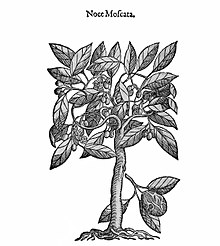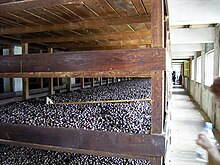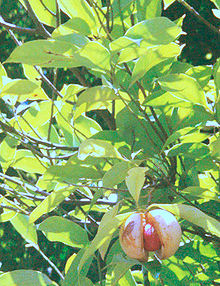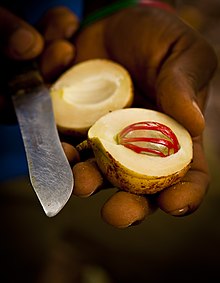Nutmeg
| Nutmeg | ||||||||||||
|---|---|---|---|---|---|---|---|---|---|---|---|---|

Nutmeg tree ( Myristica fragrans ), illustration |
||||||||||||
| Systematics | ||||||||||||
|
||||||||||||
| Scientific name | ||||||||||||
| Myristica fragrans | ||||||||||||
| Houtt. |
The nutmeg tree ( Myristica fragrans ) is a species of the nutmeg family (Myristicaceae). Its seed, the nutmeg , and its seed coat mace are used as spices ( nutmeg or mace ).
The word Muscat (from Middle High German Muscat ) or nutmeg is a borrowing from French muscat noix , which in turn from the medieval Latin nux Muscata comes and as much as "after musk -scented nuts" means.
distribution
Originally native to the Banda Islands and the northern Moluccas , nutmeg trees are now also cultivated in other areas in tropical Asia , South America and Africa . Nutmegs are Grenada's main export product and a nutmeg is therefore part of the Grenada flag .
description
In Myristica fragrans is an evergreen tree to 18 feet reached the stature heights of fifth The bark and the greenish-gray to olive-colored bark of older twigs are smooth, initially with downy hairs.
The alternate leaves are simple and stalked 6 to 12 millimeters long. The slightly leathery, elliptical leaf blade has a size of 4 to 8 centimeters, it is dark green on the top and lighter on the underside.
Myristica fragrans is diocesan , i.e. that is, there are male and female plants. Four to eight or more male flowers are located in the 2.5 to 5 cm large, short-stalked inflorescence . The 10 to 15 millimeters long stalked male flowers have three to four pale yellow, 5 to 7 millimeters long bracts and nine to twelve stamens . One to a few female flowers are in an inflorescence. The 8 to 12 millimeters long stalked female flowers have four millimeters wide, pale yellow bloom and a 6 times stamp with two almost sitting in power, small scars . The flowering period extends from March to July.
Mainly female trees are cultivated on plantations . On a 10 to 15 millimeter long stem is the ocher-yellow or orange-colored, pear-shaped to almost spherical follicle fruit when ripe , it is berry-like, but pops up. The fruit has a length of 8 to 10 centimeters and a diameter of 3.5 to 5 centimeters. The 3 cm large, round seeds are surrounded by a reddish, fleshy, oily and slashed seed coat ( arillus ). The core of the seed, like the seed coat, is used both as a spice and as a drug . In slang is called the seed as nutmeg or nutmeg and mace are as mace or nutmeg .
The short, curled cotyledons ( cotyledons ) are fused at their base.
Propagation and rearing
The usual propagation takes place from the seeds . The nuts can only germinate for 8 to 10 days and must not rattle when shaken. They are only set so deep in the earth that part of the nut is still visible. Until the germ is visible, you should put a plastic sheet over the pot and place it in a dark place. The germination time is about four to eight weeks. In any case, the nut should stay on the seedling for six to eight months.
The plant grows best at temperatures between 20 ° C and 30 ° C and should be in the shade for the first two to three years. The tree begins to bear when it is eight years old and peaks at around 15 years.
Danger
The nutmeg tree is listed in the Red List of Endangered Species of the IUCN - commonly referred to as the World Conservation of Nature Organization - as a species that has insufficient data for a hazard categorization (“ data deficient ”).
history
In ancient Egypt , nutmeg was probably not known, the "nuts" found in mummies turned out to be palm fruits, and nutmeg butter was not used for embalming. It is disputed whether the ancient doctors were already familiar with nutmeg. Theophrastus described a spice (Comacum) which has similar properties. Pliny already described this as a nut in the 1st century. In the 6th century it was already known in Byzantium , and the nuts were also introduced in China . Around the year 1000 the Persian scholar Ibn Sina described the "nut from Banda". The "fruits" of the nutmeg tree probably came to Europe with the Crusaders . The first established traditions in Europe come from Constantine the African and the Byzantine doctor Simon Seth , who wrote about nutmeg in the 10th century “that it is good for the stomach, liver and heart”, but also warned against excessive consumption , "Because then it harms the bowels ".

After the Portuguese navigator Afonso de Albuquerque had cleared the way to the so-called Spice Islands , the Portuguese began to import nutmeg from the Banda Islands to Europe for the first time in 1512 . At that time, the Spice Islands were the only place in the world where nutmegs and cloves grew. In 1563, the Portuguese doctor Garcia da Orta published a text in which, in addition to around 50 other plants, cannabis , opium and nutmeg are also described. The nutmeg then developed into the gold of East India in the 16th century . The British, Spanish, Portuguese and Dutch fought over the fruit of the nutmeg tree. In 1621 the Dutch governor-general Jan Pieterszoon Coen arrived on the Banda Islands with 2000 men and immediately began to extirpate the native population, i. H. most of the island's population was killed, an estimated 15,000, and replaced by slave labor from other areas. With this brutal approach, the Dutch secured the nutmeg monopoly trade for the next 150 years. It was not until 1753 that Pierre Poivre , the French governor of Mauritius (then Île de France ) succeeded in smuggling some nutmeg plants out of the Dutch East Indies and thus starting plantation cultivation on Mauritius. The Dutch monopoly was broken at the end of the 18th century by the English when they conquered the Moluccas. These then introduced nutmeg cultivation in Singapore , Penang , Sumatra , Sri Lanka and the West Indies .
In the battle for the nutmeg monopoly, an exchange steeped in history was made. On April 18, 1667, the British exchanged the small island of Run in the East Indian Archipelago for the much larger island of Manhattan on the American east coast, which was previously in Dutch hands and had fewer than 1000 inhabitants at the time. Today Run Island, like the other Banda Islands , can hardly be found on a map. The name of the island was shown in disproportionately large letters on engravings from the 17th century . Run Island is only about 3000 meters long and 750 meters wide. It was considered a place of fabulous riches because it was overgrown with nutmeg trees.
At the time of the Dutch supremacy, nutmeg trees were cut down on many other islands. The Dutch East India Company (VOC) wanted to build a monopoly in trade, which it succeeded at times. When nutmeg was attributed to the only effective medicine against the plague in England during the second half of the sixteenth century , the price increases were unstoppable. In 1735 the Dutch burned 570 tons of nutmegs to increase the price.
In the mid-16th century, local traders in the Banda Islands were selling ten pounds of nutmeg for less than an English penny . In England nutmeg was sold for more than two pounds sterling and ten shillings (more than the weekly wage of a worker at the time), a price ratio of 1 to 600.
ingredients
The essential oil content of nutmeg is between 5 and 13 percent. Important ingredients of the seed coat ( mace ) are 22 to 35 percent fatty oil , resins , lignans and the dye lycopene . In addition to around 40 percent fat (with the triglyceride of myristic acid as the main component), nutmegs also contain around 25 percent starch and resins . The vegetable fat is also known as nutmeg butter because of its buttery consistency .
Volatile oil
The essential oil is isolated from crushed nutmegs by steam distillation . It is colorless to slightly yellow and smells and tastes like nutmeg. The composition varies depending on the origin, processing and storage of the nuts; The terpenes α-pinene , β-pinene , sabinene , limonene , borneol , terpineol , eugenol and isoeugenol are characteristic of the aroma .
Another group of ingredients are phenylpropanoids such as myristicin , safrole and elemicin . These substances act as delirious hallucinogens . Safrol is also carcinogenic and mutagenic in rats . Myristicin can be metabolized to the psychoactive substance MMDA .
Aflatoxin problem
In the tropical climate in particular, nutmegs are not only attacked by insects but also very easily by mold , some of which produce the highly carcinogenic aflatoxins . Nuts of dubious quality (BWP - broken, wormy, punky ) may therefore not be marketed as spices. However, illegally, such nuts are occasionally sold in ground form, especially in the producing countries.
BWP nuts can, however, be processed into nutmeg oil without endangering the consumer. This is why nutmeg oil is often cheaper in stores than the equivalent amount of high-quality nutmegs.
Nutmeg butter
The so-called nutmeg butter is obtained by pressing nutmegs . It is a semi-solid, red-brown colored vegetable fat with an intense smell and taste of nutmeg. It consists mainly of triglycerides with myristic acid as the dominant fatty acid , and it also contains around 10 to 15 percent essential oil.
production

According to the Food and Agriculture Organization FAO, around 110,000 tons of nutmeg were harvested worldwide in 2018 .
The following table gives an overview of the five largest nutmeg producers worldwide, who produced a total of 92.6% of the harvest.
| rank | country | Quantity (in t ) |
|---|---|---|
| 1 |
|
38.163 |
| 2 |
|
36,242 |
| 3 |
|
16,860 |
| 4th |
|
6,849 |
| 5 |
|
3,074 |
The trade divides nutmegs into quality classes according to their size. In Grenada the size is given as the number of nutmegs per pound (454 g), while in Indonesia classes A to E are differentiated. Top quality nutmegs (60 nuts, class A) weigh just under eight grams, at the other end of the quality spectrum are the 160 nuts (class E), which weigh just under three grams.
Use of nutmeg
Nutmeg is mainly used as a spice or oleoresin , but also as an intoxicant . In folk medicine it is considered an aphrodisiac and a hypnotic .
Use in the kitchen
Freshly grated nutmeg is usually used in the kitchen because its aroma is highly volatile. The spice is used in potato dishes , soups and stews , in pastries and often in meat dishes such as meatballs and roast pork . It is also suitable as a seasoning for spinach , cauliflower , Brussels sprouts , kohlrabi , red cabbage , peas and carrots, and parsnips . The yellow-orange pulp is used to make nutmeg jelly and nutmeg syrup, which is eaten with pancakes or used for cocktails.
Nutmeg oil plays an important role in the food industry . Compared to the use of ground nutmegs, the oil offers various advantages: Because of the standardized seasoning it is easier to dose and also has a better shelf life; besides, it poses no risks because of possible Aflatoxin - contamination . It is used as a natural flavoring agent in baked goods , syrups , beverages and sweets and is part of the spice flavor preparations often sold under the name nutmeg flavoring (mostly based on wheat bran ).
Use in traditional medicine
Nutmeg is traditionally used to preserve (preserve) food, it has an antiseptic and disinfectant effect. In traditional Indian medicine of Ayurveda , it is used against diarrhea. The effect has been confirmed in pharmacological studies. It also acts as a mild analgesic . The antimicrobial effect can be helpful for infectious diseases both internally and externally. In the Indian Unani medicine, nutmeg is administered against male erectile dysfunction.
Use as a narcotic drug
The intoxicating effect of nutmeg was first described by Jan Evangelista Purkyně in 1829 . In the amounts usually used as a spice, the nut does not cause any discernible intoxicating effects; much higher doses are required for this. Nutmeg is usually taken orally; it is very rarely burned and inhaled. Due to the nauseating aroma and the unpredictable effects of such quantities, nutmeg has not been able to establish itself as a drug.
The intoxicating effect of nutmeg is mainly due to the myristicin contained in the essential oil . It has long been assumed that these substances are metabolized in the body to form amphetamine derivatives , which are responsible for the effect. According to more recent studies, in which no such substances could be detected in the urine, a direct effect is more likely. Based on the structure, there is speculation about a mode of action as a monoamine oxidase inhibitor . The information on the effect is based primarily on anecdotal reports; experiments in the hippie and student culture of the 1960s and 1970s are reported without a clear database, and there are cases of its use as a relatively cheap and easily obtainable substitute drug by people without access to more potent psychotropic drugs. Since, in addition to the desired effect, numerous unpleasant side effects such as nausea, vomiting, headache and diarrhea occur, and also undesirable psychological effects such as threatening and anxiety states are not uncommon, the use remained low.
Hallucinogenic substances are also found in the mace.
Other uses
Nutmeg essential oil is used as a flavoring in toothpaste and as a flavor corrector in medicines. In perfumery , it is often added to tart, spicy men's perfumes .
After separating the essential oil, nutmeg butter can serve as a substitute for cocoa butter or it can be used together with other fats such as cottonseed oil or coconut oil. Nutmeg butter is made from poor quality seeds in India; They are used to make candles, toothpastes, soap and perfume.
Symptoms of intoxication
Symptoms of poisoning from nutmeg are rarely reported. Of the case reports collected from American poison control centers in California and Illinois, about two-thirds and half of the cases, respectively, related to the intentional intake of larger doses to test the reported psychoactive effects as a drug, the vast majority of them in elderly patients under 20 years. Since in many cases other psychoactive substances were taken in parallel, the symptom allocation is partly unclear. Many older case histories are also based on cases of pregnant women at the end of the 19th century, when nutmeg was temporarily used as an abortion agent. Palpitations ( tachycardia ), vomiting, motor restlessness, hallucinations and drowsiness are reported. More severe or irreversible symptoms are very rare. To date, only two acute deaths have been reported, an eight-year-old boy in 1887 and a fifty-five-year-old woman in 2001; in both cases other substances (or the treatment) may have caused the death. Since no systematic studies are available, no reliable dose relationship for symptoms of poisoning can be given. Effects are described from an amount of about 1 to 2 mg of myristicin per kilogram of body weight, this can be achieved in adults with a nutmeg. However, it is unclear whether other components of the nut are not responsible for some of the effects. The symptoms typically set in about six hours after ingestion and have subsided after about 24 hours. In very few cases, chronic effects such as psychosis are reported.
Rats that were permanently fed the essential oil safrole for two years had enlarged livers and were more likely to develop liver tumors than their peers. This carcinogenic effect is likely related to the alkylation of the DNA caused by the breakdown of safrole. The lethal dose of Safrol for rats is 1.95 g / kg.
See also
literature
- Otto Warburg : The nutmeg. Their history, botany, culture, trade and exploitation as well as their adulterations and surrogates. At the same time a contribution to the cultural history of the Banda Islands. Engelmann, Leipzig 1897, digitized and through the Biodiversity Heritage Library .
- Bingtao Li, Thomas K. Wilson: Myristicaceae. In: Flora of China. Volume 7, p. 99: Myristica fragrans online
- Alberts, Mullen: Psychoactive Plants, Mushrooms, and Animals. Kosmos, ISBN 3-440-08403-5 .
- Nadja Biedinger: The world of tropical plants. DuMont Reiseverlag, Cologne 2000, ISBN 978-3-7701-5294-0 .
- Monisha Bharadwaj: The Indian cuisine. Collection Rolf Heyne, 2000, ISBN 3-453-17687-1 .
- Heiner Meininghaus: Nutmeg graters and pomander for fine spices. In: Weltkunst. 17th year, No. 14, Nov. 15, 2001, p. 2220.
- Giles Milton: Nutmeg and Muskets, the Battle for the Gold of East India. Rowohlt-Taschenbuch-Verlag, 2002, ISBN 3-499-61367-0 .
- Roth, Daunderer, Kormann: Poisonous plants, plant poisons. Nikol Verlagsgesellschaft, 2006, ISBN 3-933203-31-7 .
- Elisabeth Vaupel: Spices - Eight cultural and historical treasures. Deutsches Museum, Munich 2002, ISBN 3-924183-85-6 .
- Ingrid and Peter Schönfelder: The New Handbook of Medicinal Plants, Botany Medicinal Drugs, Active Ingredients Applications. Franckh-Kosmos Verlags GmbH & Co. KG, Stuttgart 2011, ISBN 978-3-440-12932-6 .
- EA Weiss: Spice Crops. CABI, 2002, ISBN 0-85199-605-1 , pp. 86-100.
Web links
- Nutmeg . In: Erowid . (English).
- On the toxicity of nutmeg on giftpflanze.com.
- Nutmeg and mace ( Myristica fragrans Houtt.) On gernot-katzers-spice-pages.com.
- The golden fruit of East India - a history of nutmeg spices. In: Script 1/2012 (PDF; 6.8 MB).
- Myristica fragrans in “Koehler's Medicinal Plants” (1887) .
Individual evidence
- ^ Friedrich Kluge : Etymological dictionary of the German language . Edited by Elmar Seebold. 25th, revised and expanded edition. De Gruyter, Berlin / Boston 2011, p. 642.
- ↑ Myristica fragrans in the endangered Red List species the IUCN 2009. Posted by: World Conservation Monitoring Center, 1998. Accessed January 5, 2010 ..
- ^ Otto Warburg : The nutmeg. Engelmann, Leipzig 1897, p. 2, archive.org .
- ↑ Kurt Sprengel . Theophrast's natural history of plants . Friedrich Hammerich, Altona 1822, Part I, Translation of Book IX, Chapter 7 (digitized version ) .
- ↑ Pliny 1st century. Naturalis historia Book XII, § 135 (Chapter LXIII) (Digitized Latin) ( Digitized from the Külb edition 1840–1864 German).
- ^ Ghillean Prance, Mark Nesbitt: The Cultural History of Plants. Routledge, 2005, ISBN 0-415-92746-3 , p. 166.
- ^ EA Weiss, p. 86.
- ^ Charles D. Benn: China's Golden Age. Oxford University Press, 2004, ISBN 978-0-19-517665-0 , p. 108.
- ^ Maguelonne Toussaint-Samat: A History of Food. Wiley-Blackwell, 2009, ISBN 978-1-4051-8119-8 , p. 462.
- ↑ Ibn al-Jazzār , Gerrit Bos: Ibn Al-Jazzār on Forgetfulness and Its Treatment. Royal Asiatic Society, 1995, ISBN 0-947593-12-8 , p. 40.
- ↑ Nutmeg Timeline on erowid.org.
- ^ EA Weiss, p. 87.
- ^ EA Weiss, p. 87.
- ↑ Carsten Blum: Analysis and Sensory Analysis of Spice Extracts and Spice Oils. Dissertation, University of Hamburg, Chemistry, 1999. DNB 957585888 , online ( Memento of the original from April 3, 2017 in the Internet Archive ) Info: The archive link was inserted automatically and has not yet been checked. Please check the original and archive link according to the instructions and then remove this notice. (PDF, 3.57 MB), from chemie.uni-hamburg.de, accessed on April 2, 2017.
- ↑ Oliver Kayser, Nils Averesch: Technical Biochemistry. Springer, 2015, ISBN 978-3-658-05547-9 , p. 90.
- ^ Crops> Nutmeg, mace and cardamoms. In: Official FAO production statistics for 2018. fao.org, accessed on March 21, 2020 .
- ↑ John WS Johnsson: The nutmeg: a cosmetic-erotic amulet. In: Proceedings of the Third International Congress of the History of Medicine (London, July 17-22, 1922). Antwerp 1923, p. 155 ff.
- ↑ a b Preetee Jaiswal, Pradeep Kumar, Vinay K Singh, Dinesh K Singh: Biological Effects of Myristica fragrans. In: ARBS Annual Review of Biomedical Sciences. 11, 2009, pp. 21-29, doi: 10.5016 / 1806-8774.2009v11p21 .
- ^ JE Purkinje: Some contributions to physiological pharmacology. In: New Breslau collections from the field of medicine. Vol. 1, No. 17, H. Gosohorsky, 1829, pp. 423-444.
- ↑ Steven B. Karch, Olaf Drummer: Karch's Pathology of Drug Abuse. 4th edition. CRC Press, 2008, ISBN 978-0-8493-7881-2 , pp. 323-325.
- ↑ Borwin Bandelow, Stefan Bleich, Stefan Kropp: Handbuch Psychopharmaka. 3. Edition. Hofgrefe, Göttingen 2011, ISBN 978-3-8409-2323-4 , p. 317.
- ^ AK Demetriades, PD Wallman, A. McGuiness, MC Gavalas: Low cost, high risk: accidental nutmeg intoxication. In: Emergency Medicine Journal. 22 (3), 2005, pp. 223-225, doi: 10.1136 / emj.2002.004168 .
- ^ GC Watson: Symptoms of poisoning after eating a quantity of mace. In: Prov. Med. And Surg. Journ. 1848, p. 37 f, limited preview in Google Book search.
- ^ Andrew T. Weil: The use of nutmeg as a psychotropic agent . UNOCD Unites Nations Office of Drugs and Crime Bulletin, 1/1/1966, 15-23 at unodc.org, accessed April 2, 2017.
- ^ A b Shaun D. Carstairs, F. Lee Cantrell: The spice of life: An analysis of nutmeg exposures in California. In: Clinical Toxicology. 49, 2011, pp. 177-180, doi: 10.3109 / 15563650.2011.561210 .
- ↑ Jamie E. Ehrenpreis, Carol DesLauriers, Patrick Lank, P. Keelan Armstrong, Jerrold B. Leikin: Nutmeg Poisonings: A Retrospective Review of 10 Years Experience from the Illinois Poison Center, 2001-2011. In: Journal of Medical Toxicology. 10 (2), 2014, pp. 148–151, doi: 10.1007 / s13181-013-0379-7 .
- ↑ Helena Hallström, Ann Thuvander: Toxicological evaluation of myristicin. In: Natural Toxins. 5 (5), 1997, pp. 186-192. doi: 10.1002 / 19970505NT3
- ^ N. Brenner, 0. S. Frank, E. Knight: Chronic nutmeg psychosis. In: Journal of the Royal Society of Medicine. 86, 1993, pp. 179-180.
- ↑ Safrol on catbull.com.



